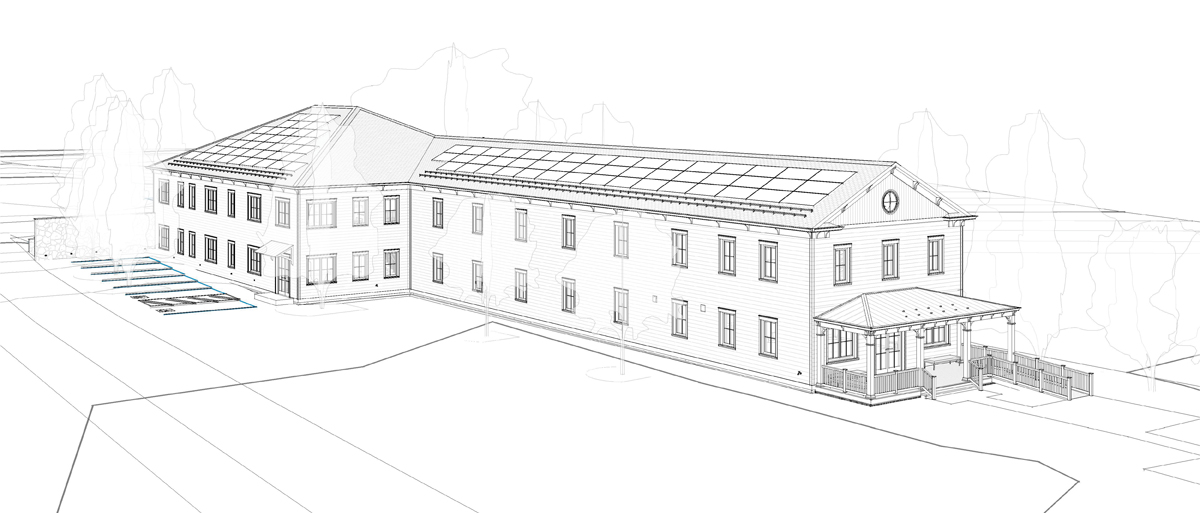Passive House Resources
By Staff | Spring 2023 | Passive House Guide
Principles
Super-Insulated Building Envelope
Continuous insulation around the entire building reduces energy demands and increases comfort. Because of the increased ability to retain heat through the building envelope (or block it in warm weather), the size of the heating/cooling system is significantly simplified and reduced.
High-Performance Windows
For single-family residential homes in the Hudson Valley (climate zones 4a, 5a, and 6a), triple-pane windows are usually necessary. In addition to better insulated glass, Passive House-approved windows reduce drafts through improved air-tightness when they are pulled closed.
Airtight Building Envelope
The building envelope is extremely airtight, preventing infiltration of outside air and loss of conditioned air. A small change in the air-tightness of a building makes a big difference and it’s accounted for from the beginning of a project. While the current building code already requires air-tightness verification, the Passive House standard is far more stringent.
Balanced Ventilation
Most homes do not have a system for delivering fresh air for healthy living. We have relied on air leaks at gaps that allow outdoor air to move in or out, such as leaky windows and doors, recessed lights and other openings, and where the house meets the foundation. These unintentional gaps also allow moisture movement, are a pathway for bugs and rodents, and introduce dust. Passive buildings use heat recovery ventilation systems (HRV), or, more commonly, energy recovery ventilation (ERV). In an ERV, exhaust air is replaced with outside air, but the heat and moisture of the air leaving the building pre-conditions the incoming air. The result is fresh indoor air with only minimal energy penalty. Incoming air is filtered, so if the windows stay closed the home will be surprisingly dust-free.
Benefits
Long-Term Cost Savings
Even as building energy codes require higher insulation levels and greater air-tightness, the Passive House standard provides a 40 percent to 90 percent reduction in energy consumption when compared to a code-built home.
Reduced Carbon Emissions
Less energy use translates directly to less carbon emitted into the earth’s atmosphere. According to the AIA Architecture 2030 plan, the building sector accounts for roughly 40 percent of our total global carbon emissions.
Increased Durability
In the old way of building, we created a leaky building envelope and then oversized our heating equipment. When the building envelope is sealed and super-insulated, the movement of water vapor can no longer have a direct avenue to dry out and can no longer cause serious durability issues.
Improved Thermal Comfort
Thermal comfort is determined by the surface temperature of a surface. If it is within seven degrees of the living area, most people will find that to be very comfortable. Every interior surface in a Passive House is verified to fall within this comfort criteria.
Superior Indoor Air Quality
A requirement for Passive House certification is a balanced ventilation system. These systems, known as HRVs or ERVs (heat/energy recovery ventilators) bring fresh air in from the outside, move it throughout the house, and then expel the stale air to the outside. In the process, the air is filtered with a MERV 13 filter (minimum requirement) which has proven to drastically reduce allergens and other particulates from the air we breathe.
The Path to Net Zero
A prerequisite for Passive House certification is the Department of Energy’s Zero Energy Ready Home program. Whether renewable energy is immediately installed on the project or not, it is engineered for the smallest energy demand possible so that net-zero energy consumption can easily be achieved.
Phius Alliance-New York
Given the momentum of certified passive building in the Northeast and with the support from NYSERDA and the national Phius organization, the Phius Alliance-Hudson Valley Chapter is rebranding in 2023 to expand its reach into all of New York State. Since January of 2023, the chapter has expanded its board of directors to include representation from Long Island (Metro NY) and Buffalo, and Rochester (Western NY) and has organized into regional committees to support ongoing Passive House specific programming in several regions. This new organization, now called the Phius Alliance-New York, continues to provide a robust membership-based network with members throughout the region and provides training, resources, marketing and advocacy support to its members. Its mission is to contribute to a low-carbon future through education, training and advocacy for the Phius standard and make it mainstream in New York and beyond. For a complete directory of chapter members, consultants, builders and verifiers, visit PHA-HV.org.
